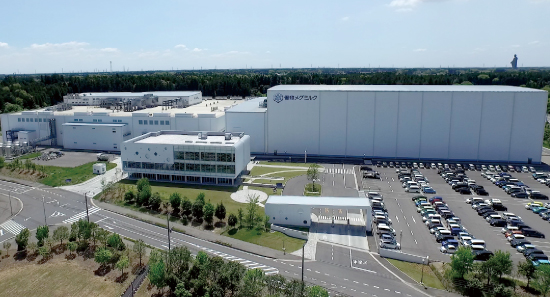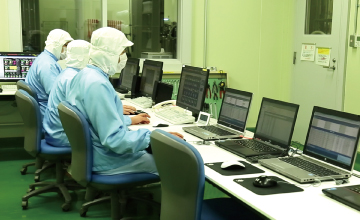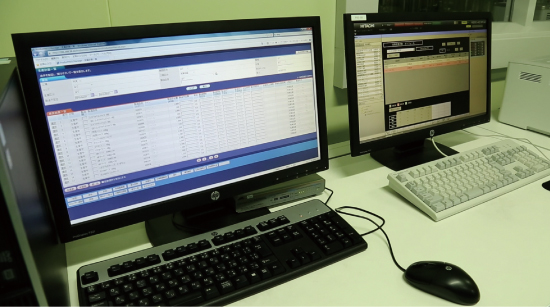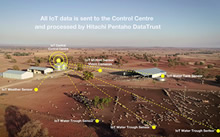Food manufacturers face the daily challenge of ensuring stable and safe supplies of food products to their customers. For its part, Megmilk Snow Brand Co., Ltd., decided to build a vast new plant to consolidate its existing plants scattered across Japan and to deliver more than 200 types of cheese, margarine, and other products to consumers under conditions that ensure reliability and safety. Hitachi worked in partnership with Megmilk Snow Brand starting from the planning stages of this new plant, with the objective of building new production and logistics systems that incorporate the latest information technologies.
The social environment of food is changing rapidly in light of globalizing food markets, labor shortages at production sites, and the increasing complexity of production and distribution chains. Beyond these factors, consumers have become increasingly concerned about food safety and dependability. In this environment, the food products industry must ensure the stable supply of reliably safe and healthy food. Taking these factors into account, Hitachi began its participation in the construction of Megmilk Snow Brand's Ami Plant in June 2011.
The vision behind the construction of the new plant was to revise the production and logistics systems in a manner that would ensure the continued growth of Megmilk Snow Brand well into the future. Construction was slated to take place in the town of Ami, Ibaraki Prefecture, where the Ami Plant would consolidate into a single location three manufacturing plants (from Kansai, Yokohama, and Atsugi) and product warehouses previously split between the Kanto and Kansai areas, thus making production and logistics systems more efficient.
Hitachi participated from the basic planning stages of the integrated production management system, the key component to improving efficiency at the new plant. The system was designed to ensure the stable supply of safe and reliable food products by incorporating information technologies into production and logistics systems.

Exterior of the Ami Plant

Some of the dairy products made at the Ami Plant
The construction of the Ami Plant and the associated planning work represent the largest project in Megmilk Snow Brand's history. The company began by identifying three goals for the construction project:
Essential to achieving these three goals was the development of an integrated production management system: that is, an IT system to support production at the plant.
In addition to developing subsystems for production management, manufacturing processes, line management, and the control of various devices, the newly developed integrated production management system needed to be able to link to and coordinate with other systems, including systems for demand/supply planning, business performance management, and logistics and warehouse management. Assigned overall responsibility for the plant's IT systems, Hitachi made the adjustments needed to ensure the successful integration of individual systems.
Furthermore, Hitachi coordinated the integrated production management system and the manufacturing and inspection equipment to be installed in the plant within a short timeframe and proposed total solutions for other equipment not necessarily within the scope of information (IT) or operations technology (OT), including generators, air conditioning, and freezers. In May 2015, some five years following the basic planning stage, the integrated production management system was completed, concurrently with the completion of construction on one of Japan's largest dairy-product production facilities.

The central control room provides an overview of operations ranging from centralized production status management for dairy products to monitoring of various other systems, including those used to manage transportation and materials
Production lines where numerous new technologies have been introduced to enable centralized management by the integrated production management system
The Ami Plant's integrated manufacturing management system is based on Hitachi's Product NEO, a manufacturing execution system (MES) for plants that links management directly to the production worksite. The system represents a distillation of all the expertise Hitachi has accumulated to date in building production management systems for the food products industry.
This integrated production management system achieved the plan's initial goals in the following ways:
In these ways, Product NEO has played a major role in implementing integrated control of the plant. By fusing the domains of IT (managing production processes) and OT (production lines and equipment), it has made it possible to control, in real-time, processes ranging from order receipt to production and shipping. The successful deployment of these next-generation production and logistics systems ensures the stable supply of safe and reliable food products.

Putting accumulated data to use to ensure the plant's continuing evolution
When the construction plan for the Ami Plant was first considered, almost no one had heard the term “Internet of Things” (IoT). Even so, the plant's equipment incorporates countless sensors to maximize the power of IT. Future plans call for evolving the plant into a smart plant based on the analysis and use of data obtained from these sensors to increase yields for cheese and other products and improve facility maintenance.
Since operations began, the Ami Plant's integrated production management system has operated smoothly and generated significant results. Many other companies are also planning to revise their manufacturing workplaces to address various issues and improve management. Amid these circumstances, Hitachi will continue to propose innovative solutions in the manufacturing field through collaborative creation with its customers as part of its mission to achieve social innovation.
Video:Hitachi's Manufacturing Control Solutions
Release Date:March 2017
Solutions By:Hitachi, Ltd. Industry & Distribution Business Unit







